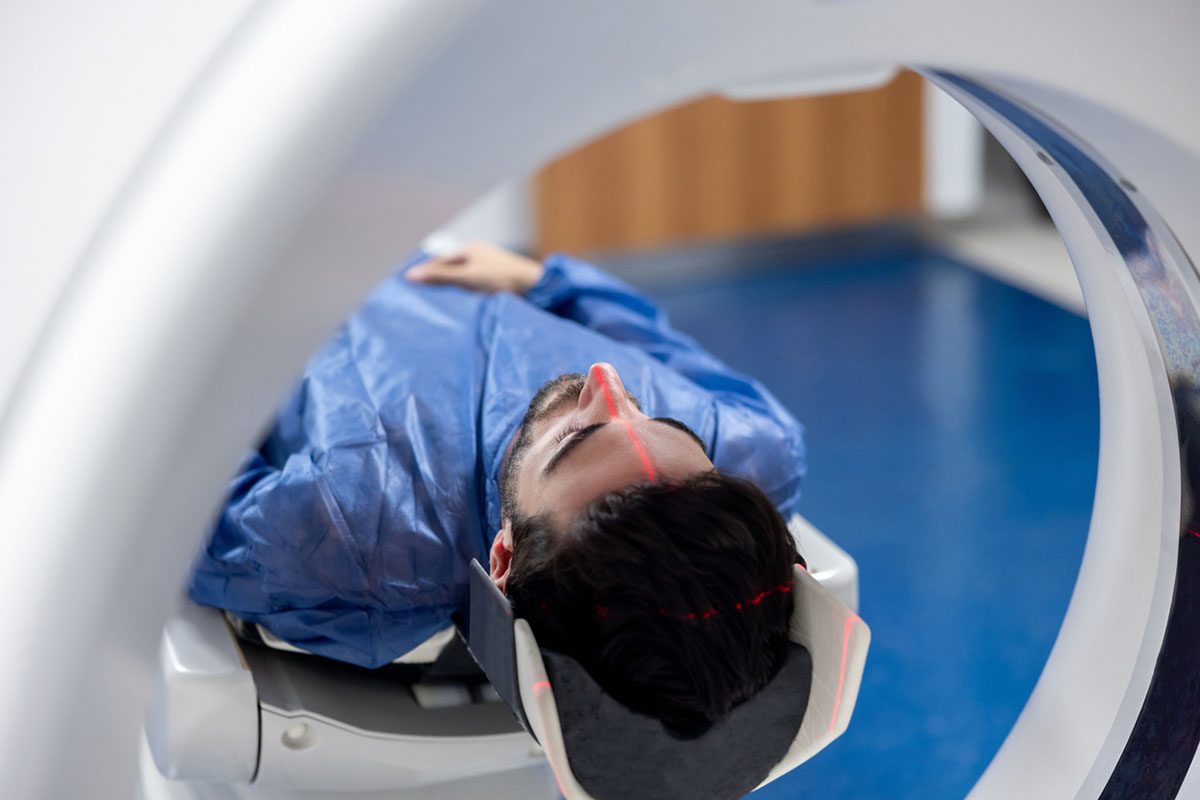
Prim Care Companion CNS Disord 2021;23(5):20cr02892
To cite: Chen A, Sharoha N. Valproate efficacy for agitation management in a patient with paroxysmal sympathetic hyperactivity due to traumatic brain injury. Prim Care Companion CNS Disord. 2021;23(5):20cr02892.
To share: https://doi.org/10.4088/PCC.20cr02892
© Copyright 2021 Physicians Postgraduate Press, Inc.
aDepartment of Psychiatry, Stony Brook University Hospital, Stony Brook, New York
*Corresponding author: Nidhi Sharoha, DO, Department of Psychiatry, Stony Brook University Hospital, Stony Brook, NY 11794 ([email protected]).
Paroxysmal sympathetic hyperactivity (PSH) is a clinical phenomenon characterized by symptoms of sympathetic stimulation such as increased heart rate, blood pressure, temperature, and diaphoresis as well as motor symptoms including agitation, hypertonia, and spasticity.1 While the etiology is debated, it is most commonly associated with traumatic brain injuries (TBIs). Its prevalence among TBI patients is debated as well, but estimates range from 7.7% to as high as 33%.1
There have been significant questions raised regarding the diagnostic criteria for PSH, with a consensus process established in 2014.2 The PSH Assessment Measure (PSH-AM) consists of 2 parts: the first is the Clinical Feature Scale (CFS), which assesses for tachycardia, tachypnea, hypertension, hyperthermia, posturing, and diaphoresis.2 The second part is the Diagnostic Likelihood Tool (DLT), which assesses for features associated with PSH such as an antecedent acquired brain injury, paroxysmal episodes, occurrence 2 weeks after the brain injury, and length of symptoms greater than 3 days.2 One symptom that does appear to be missing is agitation, although it has frequently been described as a clinical feature present in PSH.1 This lack of diagnostic clarity can lead to challenges to treatment, especially when patients present with both PSH and agitation after a new TBI.
There is still debate about the pathophysiology of PSH as well as its duration. One of the more recent theories is the excitatory:inhibitory ratio model.3 In this model, PSH is a 2-step process. First, there is increased spinal circuit excitation from disconnection of descending inhibitory pathways. Second, normally innocuous sensory inputs trigger strong sympathetic responses.2 There also have been attempts to localize the structural lesions that may lead to PSH with no clear results.2 A variety of medications have been used to address PSH in general including opioids, γ-aminobutyric acid (GABA) agonists, α-agonists, and antipsychotics.4 However, literature on the treatment options for PSH-associated agitation is sparse. Valproate is not mentioned as a potential treatment for PSH-associated agitation despite its use in treatment of agitation in TBI patients.5
In this report, we present a case wherein divalproex sodium, a commercial preparation of valproate, was used successfully in conjunction with other agents to treat a patient with PSH and severe agitation following TBI.
Case Report
A 38-year-old man with no known medical history presented to the hospital after being ejected from his vehicle following an accident. He was the driver and was going 60 miles per hour at the time of the accident. He was combative when found by emergency medical technicians and was given fentanyl, etomidate, and succinylcholine before intubation and sedation in the field. On presentation to the local trauma center, large lacerations were noted on the back of his head. Head imaging showed left anterior frontal epidural hematoma with mass effect, left superior frontal gyrus hemorrhagic contusion, and subarachnoid hemorrhage anterior to the left temporal pole. He was immediately taken to the operating room to undergo a left-sided craniotomy with hematoma evacuation and scalp closure. After the procedure, he was admitted to the surgical intensive care unit and remained intubated and sedated.
On admission, the patient’s urine toxicology screen was positive for cocaine, cannabinoids, amphetamines, benzodiazepines, and fentanyl. Collateral information obtained from his sister provided a history of significant alcohol use as well as other substances by the patient, reportedly to deal with depressive symptoms. He had never received any mental health treatment and had no formal diagnoses of any psychiatric illnesses. There were no prior hospitalizations. He also had never received any substance or alcohol use disorder treatment. Soon after the operation, his postoperative course was complicated by significant episodes of agitation as well as autonomic instability characterized by profuse sweating and tremors. Initially, this was thought to be secondary to substance withdrawal, so he was treated with intravenous (IV) lorazepam as well as high doses of sedatives including propofol, fentanyl, and dexmedetomidine. However, the patient remained agitated and physically aggressive, requiring restraints almost daily. The psychiatry department was consulted, and the patient was deemed to be delirious. He was then started on standing risperidone and divalproex with as-needed haloperidol to treat particularly severe episodes of agitation.
He was eventually extubated around 14 days after admission. He was noted to have significant deficits in cognition, and he was oriented only to person but not to place or time. Notably, he had trouble following even simple commands like “close your eyes.” Although he appeared less diaphoretic and tremulous, he continued to have behavioral issues complicating treatment. Over the next few weeks, it became apparent that the patient was exhibiting signs of a major neurocognitive disorder due to a TBI. He was switched to different antipsychotics such as aripiprazole and olanzapine in an effort to control his aggression while avoiding any further neurotoxic effects. Propranolol was also started to further address his aggression and impulsivity. However, the patient continued to have significantly dangerous impulsive behavior, for example pulling out his IV lines, trying to take off his clothes, and attempting to leave the hospital. The decision was made to place him on standing haloperidol instead of risperidone. On haloperidol, divalproex, and propranolol, the patient’s behavior became more manageable. His cognition was also improved as well to the point that he was alert and oriented to person, place, and time. At this time, he was awaiting discharge to a TBI clinic.
However, as the patient’s hospital course progressed, he became diaphoretic, rigid, and tremulous, with prominent hyperreflexia along with episodes of autonomic instability characterized by tachycardia, tachypnea, and hypertension. There was no identifiable precipitant event. Based on the PSH-AM, the patient scored a 13 on the CFS and 8 points on the DLT for a total of 21 points. A diagnosis of PSH was made. Haloperidol and divalproex were stopped due to concerns for adverse effects contributing to this presentation. The propranolol dosage was increased to 20 mg 3 times daily. Gabapentin and clonazepam were also added due to the severity of the patient’s PSH. While there was improvement in his diaphoresis, rigidity, and posturing, he continued to have episodes of severe agitation including hitting and kicking at staff along with sexually inappropriate behavior. Eventually, he needed 2 staff members with him at all times for constant redirection and safety. He continually required as-needed antipsychotic medications, both by mouth and intramuscularly, for his dangerous behavior. Divalproex was restarted for severe agitation along with a low dose of quetiapine due to concerns for some hypersexual behavior. Divalproex was eventually titrated up to 750 mg in the morning and 1,000 mg at bedtime. He remained on propranolol and gabapentin, while clonazepam was discontinued. The patient’s agitation improved significantly after divalproex was restarted, and he no longer needed any as-needed medications for agitation or constant staff supervision. He was pleasant, more aware of proper social etiquette, and patiently participated in his care. Neuropsychological testing done about 3 months after admission showed marked impairments in executive function and language with some semantic paraphasia along with poor insight and judgment. With his behavior controlled, he was discharged to a facility.
Discussion
Divalproex sodium is a commercial preparation of valproate consisting of equal parts sodium valproate and valproic acid.6 Its mechanism of action is not fully elucidated, but it is theorized to increase brain concentrations of GABA and block voltage-sensitive sodium channels.7 It has also been theorized to have an antikindling effect on the limbic system in relation to emotions and behavior.8,9 While valproate is not known as a common treatment for PSH-associated agitation, it is more often used as a treatment for agitation in patients with TBI.10 A previous review11 found that valproate was effective in reducing aggression and violence among different populations including those with dementia, organic brain syndromes including TBIs, intellectual disability, and Axis I psychiatric diagnoses.
However, we found no studies in the literature on the use of valproate for agitation management in a patient with PSH. While there are a variety of treatment options for PSH in general, most of these options are tried based on a few case reports and case series, thus providing limited evidence on their potential use in agitation management.4 Among the agents selected include nonselective β-blockers, α2-agonists, and dopamine agonists such as bromocriptine, baclofen, gabapentin, long-acting benzodiazepines, and opioids. Because the pathophysiology of PSH is not fully understood, the mechanisms by which these medications improve symptoms of PSH are not completely clear. In addition, while these agents may address the autonomic symptoms of PSH well, they may not treat agitation adequately. While the patient in this case was being treated with agents such as gabapentin, propranolol, and clonazepam, which are frequently used in PSH, his aggression and inappropriate behavior persisted until divalproex was introduced. Use of antipsychotics was challenging in this patient, as he had severe rigidity and tremors due to PSH. Thus, divalproex served the purpose of managing the patient’s agitation without aggravating his PSH symptoms. Among medications that have been used to treat PSH in the literature are baclofen and propofol, both of which are GABA agonists, and benzodiazepines, which enhance GABA activity.3,11 This suggests one possible mechanism of the efficacy of valproate in treating PSH-associated agitation. It is also possible that valproate’s overall efficacy for addressing violence and aggression extends to patients with PSH and may be a useful alternative to benzodiazepines and antipsychotics. This case highlights the importance of consideration of valproate as the primary agent of choice in patients with PSH-associated agitation, as it may decrease length of hospital stay and help to avoid a complicated hospital course. Further research into the benefits of valproate in this patient population is needed to determine optimal dosing and to guide management when these patients develop severe bouts of PSH.
Conclusion
PSH is a challenging syndrome with a significant prevalence among TBI patients. Agitation management in patients with a new-onset TBI and PSH can be a difficult task. Valproate has already shown efficacy in the management of patients with agitation. However, it likely can also be beneficial in the setting of PSH. Although agitation is not seen as a diagnostic criterion for PSH, its occurrence can prove to be a challenge for patients and providers. Valproate should be considered as an efficient alternative to other psychotropic agents for agitation management in patients with TBI and PSH, especially when bouts of PSH become prolonged and difficult to manage.
Published online: October 14, 2021.
Potential conflicts of interest: None.
Funding/support: None.
Patient consent: Consent could not be obtained given that the patient was severely cognitively impaired; however, information has been de-identified to protect anonymity.
References (11)

- Perkes I, Baguley IJ, Nott MT, et al. A review of paroxysmal sympathetic hyperactivity after acquired brain injury. Ann Neurol. 2010;68(2):126–135. PubMed CrossRef
- Meyfroidt G, Baguley IJ, Menon DK. Paroxysmal sympathetic hyperactivity: the storm after acute brain injury. Lancet Neurol. 2017;16(9):721–729. PubMed CrossRef
- Baguley IJ, Heriseanu RE, Cameron ID, et al. A critical review of the pathophysiology of dysautonomia following traumatic brain injury. Neurocrit Care. 2008;8(2):293–300. PubMed CrossRef
- Samuel S, Allison TA, Lee K, et al. Pharmacologic management of paroxysmal sympathetic hyperactivity after brain injury. J Neurosci Nurs. 2016;48(2):82–89. PubMed CrossRef
- Connolly S, Caldwell SB, Wilson FC. Maintaining community living with post brain injury agitation: a role for sodium valproate. Brain Inj. 2013;27(6):754–757. PubMed CrossRef
- Depakote (divalproex sodium) [package insert]. US Food and Drug Administration. Revised October 2011. Accessed June 15, 2020. https://www.accessdata.fda.gov/drugsatfda_docs/label/2011/018723s037lbl.pdf
- Stahl SM. Stahl’s Essential Psychopharmacology: Prescriber’s Guide. 5th ed. Cambridge, UK: Cambridge University Press; 2014.
- Wroblewski BA, Joseph AB, Kupfer J, et al. Effectiveness of valproic acid on destructive and aggressive behaviors in patients with acquired brain injury. Brain Inj. 1997;11(1):37–47. PubMed CrossRef
- Kalra ID, Watanabe TK. Mood stabilizers for traumatic brain injury-related agitation. J Head Trauma Rehabil. 2017;32(6):E61–E64. PubMed CrossRef
- Mehta S, McIntyre A, Janzen S, et al. Pharmacological management of agitation among individuals with moderate to severe acquired brain injury: a systematic review. Brain Inj. 2018;32(3):287–296. PubMed CrossRef
- Lindenmayer JP, Kotsaftis A. Use of sodium valproate in violent and aggressive behaviors: a critical review. J Clin Psychiatry. 2000;61(2):123–128. PubMed CrossRef
Please sign in or purchase this PDF for $40.




